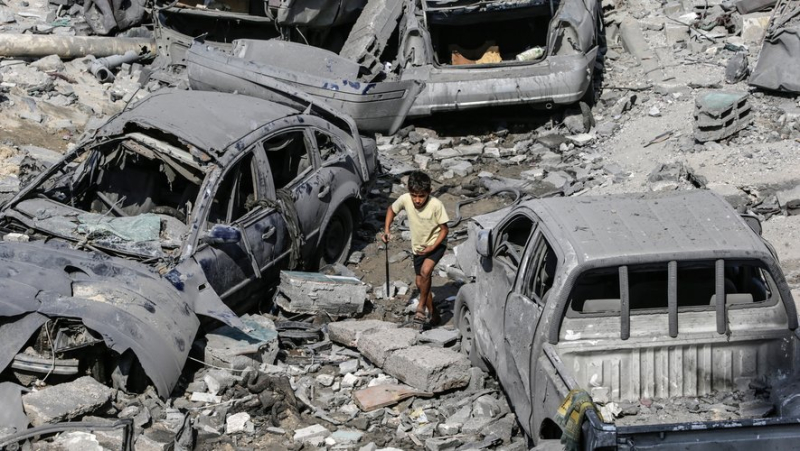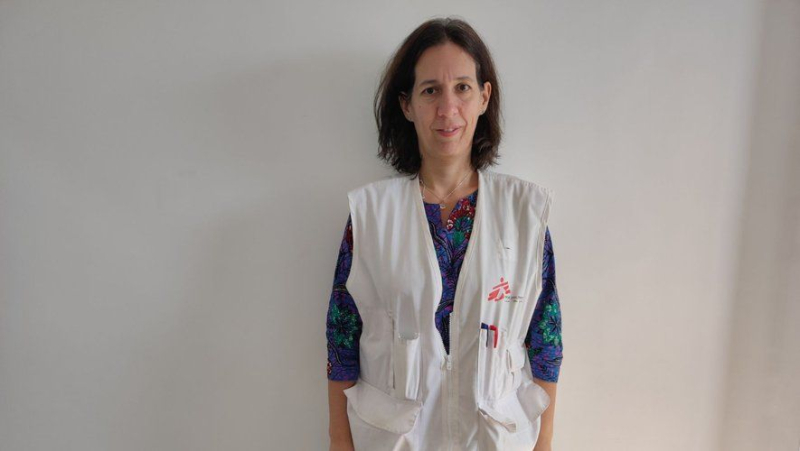“A vision of horror, apocalyptic landscapes, it's Dantesque”: the testimony of a humanitarian in the hell of Gaza

Gaza CIty, 9 octobre 2023 : l’offensive israélienne vient de débuter. EPA – MOHAMMED SABER
Aurélie Godard, 43, an anesthesiologist and intensive care physician, has been to the Gaza Strip twice in recent months to direct the medical activities of Doctors Without Borders (MSF). She has been back on site since Tuesday with the NGO International Medical Corps. Testimony.
What is the situation in Gaza ?
The living conditions are absolutely terrible and the situation is getting worse, with constant population movements, people crowding into ever-shrinking spaces on a sidewalk, a vacant lot.
According to a United Nations estimate, they have an average of 1.5 m2 of living space per person and still have the same difficulties in obtaining water and food.
And then added to this were even greater difficulties in delivery with the Israeli army taking over the Rafah border crossing between the Gaza Strip and Egypt, where most humanitarian aid passes.
For several weeks, nothing came in, neither food nor medicine, before arrivals in dribs and drabs, now controlled by Israel, and evacuations of the wounded and sick almost at the stop.
In this context, how is the rescue organized ?
We found ourselves out of medicines, equipment, forced to space out dressing changes, crossing our fingers that it wouldn't get infected, re-sterilizing things that we should have thrown away, these are not the procedures, but we do what we can, by degrading the quality of care which is already far from optimal, by making penny-pinching savings.
You have no visibility on what you are going to be able to receive, you sometimes see a truck arrive with the machine you were waiting for but half the parts are missing so it is unusable.
And there are these mass bombings that hit humanitarian areas, there is polio…
Have the pauses decreed to carry out vaccination campaigns been sufficient ?
No, they allowed for part of the vaccination coverage, but were largely insufficient and the campaigns were very complicated, particularly in the North. And tomorrow it will be measles, cholera, we are unfortunately entering the phases of all these major communicable diseases, epidemics, because people are displaced and there is no longer any follow-up.
In Nasser, for example, the hospital archives were burned quite selectively, all the medical records were destroyed.
For what purpose do you think ?
In the same way that town halls and civil infrastructure are destroyed, you can no longer ask for a birth certificate, an identity document, we perceive this desire to make life in Gaza impossible and care non-operational.
The situation can only deteriorate.
We had to evacuate our hospital in Rafah to redeploy our activities in Khan Younes (southern Gaza Strip). We had to rehabilitate a good part of the Nasser hospital, left upside down after the invasion of the Israeli army, all the false ceilings were ripped open, all the windows exploded, the computer motherboards were taken away by the Israeli army, the computer system was not working.
The health system is being systematically and organizedly undermined.
What does the population lack the most ?
Humanity. They have stopped hoping, they are reaching the exhaustion of their compensation mechanism, of resilience, behind the litany of figures, there are displaced people who do not know if they will be alive tomorrow, it is written in their flesh. They lack everything and they lack a future.
Israel is razing the Gaza Strip, it's a vision of horror, with gutted facades, apocalyptic landscapes, like in the movies, it's Dantesque.
In Lebanon, “nothing is certain anymore”
“ Last night the bombings were very. strong and close.”» In the southern suburbs of Beirut, where he lives near the Hezbollah district, Guillaume Bruté de Rémur from Montpellier has been witnessing the intensification of Israeli strikes for several days, now supported by a ground offensive. “The population is very affected,relates this 55-year-old priest, 25 of which he spent in this country devastated by endless wars. After the assassination of the leaders of Hezbollah, the Iranian response, 200 missiles fired at Israel on Tuesday evening, “ restarted the machine that seemed to have slowed down", he worries. Repatriations "On Wednesday, when the Iranian bombings were announced, the neighboring neighborhood came alive and we heard a lot of machine gun fire, an expression of joy. Surrealist." The Lebanese now do not know what awaits them. "Everyone feels that nothing is certain anymore", says the Hérault resident. Many are trying to flee the country, where more than 20,000 French people live. Paris has deployed an amphibious helicopter carrier and started repatriating the most vulnerable people. Often the only escape. “Flights leaving Beirut are packed until almost the end of the month, reports Guillaume Bruté de Rémur. And the Christian neighborhoods have filled up with Shiite refugees who have left their homes.” Over the past year, more than a million Lebanese have been displaced. More than 1,900 people have been killed and 9,000 injured, according to Lebanese authorities.
To achieve this level of destruction, an unimaginable level of violence was required. All NGOs agree that what is happening there does not respect international and humanitarian law.
There is not a single Palestinian in the hospital who is not psychologically traumatized today. The needs in mental and psychological health are going to be absolutely colossal, obviously among children, but not only them.
You see desperate populations fleeing tanks, drones, snipers, on small carts pulled by skeletal donkeys on which they have piled up the few possessions they have left, two or three mattresses, a plastic chair, often with an endless weariness in their eyes.

Palestinians flee death and devastated cities. MAXPPP – IMAGO/Omar Ashtawy apaimages
And sometimes, in a somewhat unheard-of way, you see life resume amidst the rubble, with kids going to play in puddles of water, clotheslines stretched between a piece of wall and a post.
Many humanitarian workers died on the spot. Does this fear accompany you in your daily life??
Yes, caregivers are also caught up in this daily terror. There are two ways to get around. The first is to do what you want, at your own risk.

Aurélie Godard has twice led MSF's medical operations in the Gaza Strip in recent months. DR
The second is to warn the Israeli army by giving them the names of the passengers, the time, the precise route, etc. But I participated in a convoy with the United Nations in the north of the Gaza Strip, where they stopped our driver at the checkpoint and undressed him, even though they had validated all the information beforehand. Convoys are sometimes targeted by Israeli tanks.
Danger is everywhere, even when you take the maximum possible precautions.
Do the numbers of dead and wounded in Gaza, figures controlled by Hamas, seem to you to be in line with reality ?
They are, in my opinion, even below reality, firstly because the figures given by Hamas on other conflicts have always ended up being corroborated a posteriori by Israel. Then because people, families take the bodies to the hospital to be recorded.
But what is missing in all this are all those who are still under the rubble, or missing and indirectly injured, complications from routine care, a man who has a heart attack and cannot get to the hospital, a woman who dies after a caesarean that could not be performed under good conditions. All these deaths are not counted in the reports.
In Israel, the kibbutz of Be'eri between hope and pain
Avida Bachar runs her fingers over a steel door riddled with bullet holes and still marked with the blood of her son, Carmel, 15, who was killed on October 7, 2023. His wife, Dana, also died that day when attackers stormed into Kibbutz Be’eri, one of the hardest-hit communities. The village, located 5 km from the Gaza Strip, lost a tenth of its 1,000 residents. Avida Bachar's home had a safe room where the family took refuge that morning. But the shelter did not withstand the assault of dozens of fighters who shot at the door, threw grenades through the windows and set the house on fire. At 51, Avida Bachar, who lost one of her legs in the attack, remains hopeful that the kibbutz will, with time, heal its wounds. The optimism of Hadar, her 14-year-old daughter who was also injured, keeps her going. “She is ten times stronger than me. Young people live in the present. When I imagine her getting married in a few years, without her mother, I collapse.”, he confides. Kibbutz Be’eri was founded in 1946 with the aim of creating a collective, egalitarian farming community. “It will take time not only to rebuild Be’eri, but to restore confidence in the idea of the kibbutz as a safe haven," says Iftah Celniker, the group's leader. In Be’eri, 10 people were captured. At least three are believed to still be alive. The body of Carmel Gat, 40, was found in a Hamas tunnel, along with the bodies of five other hostages. Israeli authorities say their captors shot them as IDF troops approached. A photograph of Carmel, smiling, has been placed on the ruins of the family home. Her younger brother, Or, rummages through the rubble of a destroyed life. “Our safety will never be the same, but this is the place of our lives, in the happy times and the horrible times. This is our place of life, our place of struggle,” he emphasizes.
I subscribe to read the rest




